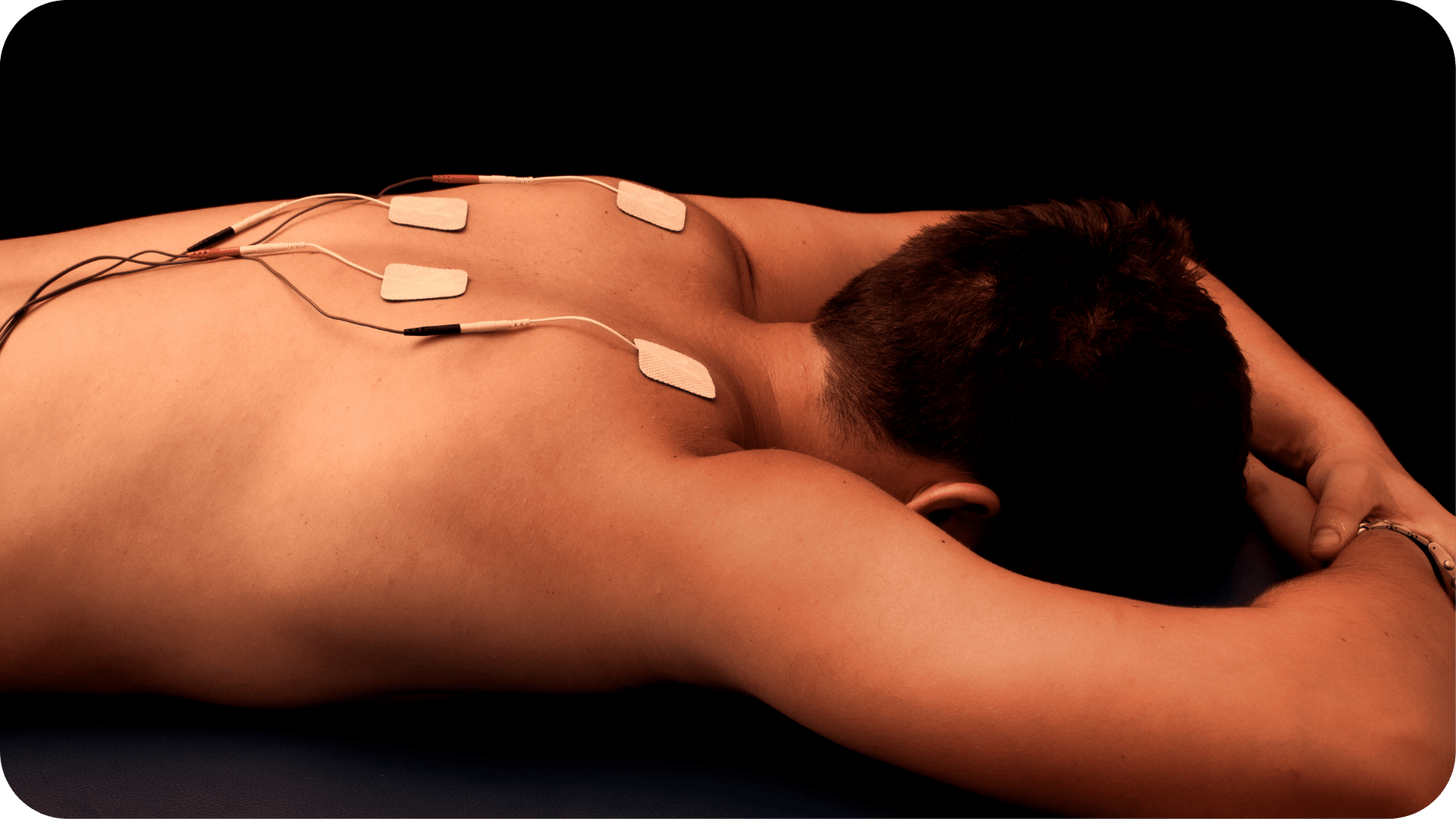How do you know if interferential current stimulation therapy may be a treatment option for you?
01
You have muscle spasms, joint damage, edema, muscle strains, or sports injuries.
02
You’re looking for some relief from the chronic pain.
03
Taking a ten to twenty minute break to heal your body sounds nice.
04
You want to work with a team to understand and treat the root cause of your pain.
What is interferential therapy used for?
Interferential current therapy (ICT or sometimes shortened to IFC or IFT) is the most common form of electrical muscle stimulation. It is a noninvasive, drug-free, therapy with minimal side effects. At Loehr Health Center, ICT is used in conjunction with other modalities like chiropractic care and decompression therapy to promote healing.
It is used to treat:
- Back pain
- Neck pain
- Radiating pain or tingling in the legs and/or arms
- Reduced ranges of motion
- Low back pain
- Sciatica
- Shoulder pain
- Sports injuries
- Pain from muscle spasms
- Whiplash
- And more!
*There are a wide range of therapies available at Loehr Health Center. Your provider will discuss which treatments they think may be a right fit for you including athletic training prolotherapy, decompression therapy, or seeing a chiropractor.
What is interferential current therapy?
Interferential current therapy is a form of electrical therapy that uses a pair of electrodes containing two independent circuits, high frequency (4,000 Hz) and medium frequency (150 Hz), alternating currents.
It utilizes a higher frequency than traditional electrical current therapy. By applying a higher frequency current, it is more easily passed through the skin. This requires less electrical energy input to reach the deeper tissues and lessens discomfort for the patient during the treatment than low frequency stimulation.
Interferential therapy is thought to be more comfortable and effective than traditional transcutaneous electrical stimulation (TENS).

The primary clinical applications for interferential therapy are
- Alleviating pain without an invasive procedure or medications
- Increasing blood flow to the targeted area
- Reducing pain
- Stimulating muscles
- Improving range of motion
- Reducing inflammation
Electrical current therapies, like interferential therapy, work to provide pain relief by exciting the sensory nerves and stimulating the body’s natural opioid system and/or the pain gate mechanism.
What is pain? How does the nervous system react to pain?
Interferential Current Therapy FAQs and Answers
You are completely clothed during your interferential therapy session. Your provider will ask you to lie on your stomach or back on a therapy table. (Depending on the area being treated, you may be asked to sit upright in a chair instead.)
Your provider will then apply the electrodes to the area of the skin correlating with the targeted muscles. Then, the machine will be turned on the lowest setting. Your provider will ask you when you can feel the muscles contracting. The muscles should feel like they are gently contracting, but not “jumping” or causing a sharp sensation. Once the machine is set to your comfort level, the session will usually take ten to twenty minutes.
Loehr Health Center’s clinical team takes a multidisciplinary approach to managing and treating spinal disorders. Interferential therapy is usually part of an individualized treatment plan that includes spinal adjustments with a chiropractor. The cost of interferential therapy per treatment is $25.
Interferential therapy is a non-invasive treatment with minimal side effects. You will feel your muscles contracting during interferential therapy. Patients report a buzzing or tingling sensation on the skin.
The most common side effects from electrical stimulation therapies is due to an allergic reaction (about 2-3% of patients) due to the adhesive used to hold the electrodes in place or a conductive gel that may be applied to the skin. Notify your provider if you have a known allergy.
Notify your provider immediately if you feel your pain is increasing during an interferential treatment. Your muscles should feel like they are gently contracting. The feeling should be bearable and not painful.
- Interferential therapy is not recommended for patients who:
- Are allergic to the electrodes, gel, or tape
- Have a Pacemaker or implanted electronic device
Pregnant patients may receive interferential therapy at the recommendation of their provider using an alternate protocol.
Interferential therapy MAY be covered by some insurance plans.
For many other services at our office, we are in-network with various insurance companies. We will run your insurance benefits prior to your first appointment so that you know what is covered before receiving treatment.
The type of and frequency of treatments that are recommended to you’re you achieve your health goals depends on the severity of your condition and pain level.
Your doctor will complete an exam and discuss any recommended diagnostic or lab tests needed with you at your first appointment. At your Report of Findings appointment (usually the second appointment), your doctor will review the results of your exam and any tests like x-rays, MRIs, and/or lab work.
At that time, your doctor will review their recommended treatments, the frequency of care, and the action plan.
Loehr Health Center is committed to providing all of our patients with exceptional care. When a patient cancels without giving enough notice, they prevent another patient from being seen. Please call us at 417-887-8075, 24 hours prior to your scheduled appointment to notify us of any changes or cancellations. If prior notification is not given, you will be charged for the missed appointment.
Interferential Current Therapy Research
Effect of interferential current therapy on pain perception and disability level in subjects with chronic low back pain: a randomized controlled trial
| Clin Rehabil. 2017 Feb;31(2):242-249. Epub 2016 Jul 10. doi: 10.1177/0269215516639653.
Conclusion: “A two-week transregional interferential current treatment has shown significant short-term efficacy, when compared with a ‘usual care’ protocol, on self-perceived pain and functionality in subjects with chronic low back pain.”
Transcutaneous electrical nerve stimulation and interferential current demonstrate similar effects in relieving acute and chronic pain: a systematic review with meta-analysis | Braz J Phys Ther. 2018 Sep-Oct; 22(5): 347–354. Published online 2018 Feb 2. doi: 10.1016/j.bjpt.2017.12.005
Conclusion: “Eight studies with a pooled sample of 825 patients were included. The methodological quality of the selected studies was moderate, with an average of six on a 0–10 scale (PEDro). In general, both transcutaneous electrical nerve stimulation and interferential current improved pain and functional outcomes without a statistical difference between them.”
Loehr Health Center uses inteferential therapy to improve patient outcomes. Interferential therapy is more comfortable for the patient than transutaneous electrical nerve stimulation (TENS).
Interferential current therapy | Br J Sports Med. 1990 Jun; 24(2): 87–92. doi: 10.1136/bjsm.24.2.87
Conclusion: “Research suggests that interferential therapy can effectively stimulate voluntary muscle, promote peripheral blood flow, and accelerate bone healing. Empirical observations support a case for using this technique to reduce pain and control incontinence. Interferential therapy would seem to present a valuable adjunct to the medical and physiotherapy management of the pathologies seen frequently by those specializing in sports medicine…interferential therapy will continue to grow in importance as a versatile and effective approach to therapy.”
Interferential current therapy in patients with knee osteoarthritis: comparison of the effectiveness of different amplitude-modulated frequencies | Am J Phys Med Rehabil. 2012 Feb;91(2):107-13. doi: 10.1097/PHM.0b013e3182328687.
Conclusion: “This study demonstrated the superiority of the IFC with some advantages on pain and disability outcomes when compared with sham IFC for the management of knee osteoarthritis. However, the effectiveness of different amplitude-modulated frequencies of IFC was not superior when compared with each other.”


